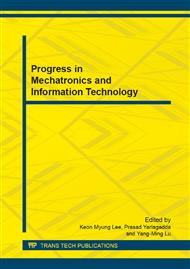p.1068
p.1072
p.1076
p.1081
p.1087
p.1093
p.1097
p.1102
p.1106
Architecture Model of FMS Based on Multi-Agent Technology
Abstract:
The concept of flexible manufacturing system (FMS) has been purposed to improve flexibility and efficiency of manufacture system. Characteristics and operating mechanism of FMS is analyzed in this paper. Fuzziness and distributive of the Multi-agent system can meet the requirements of building FMS platform. On the basis of the theory mentioned above, this paper proposed an architecture model of FMS based on multi-agent technology. At last, the communication between the agents in the system was researched and designed. The introduction of multi-agent technology not only provides a feasible method of building FMS platform system, but also helps to lucubrate the architecture of FMS.
Info:
Periodical:
Pages:
1087-1092
Citation:
Online since:
November 2013
Authors:
Keywords:
Price:
Сopyright:
© 2014 Trans Tech Publications Ltd. All Rights Reserved
Share:
Citation:


